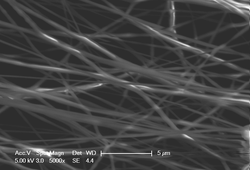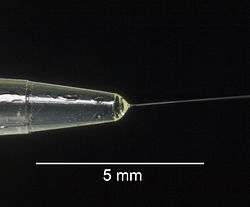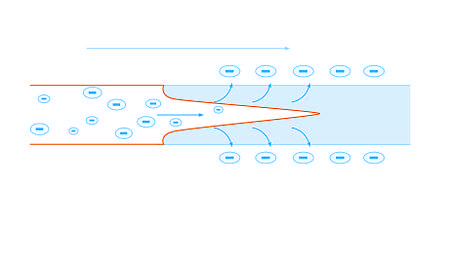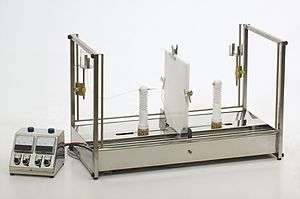Electrospinning


Electrospinning is a fiber production method which uses electric force to draw charged threads of polymer solutions or polymer melts up to fiber diameters in the order of some hundred nanometers. Electrospinning shares characteristics of both electrospraying and conventional solution dry spinning of fibers.[1] The process does not require the use of coagulation chemistry or high temperatures to produce solid threads from solution. This makes the process particularly suited to the production of fibers using large and complex molecules. Electrospinning from molten precursors is also practiced; this method ensures that no solvent can be carried over into the final product.
Process
When a sufficiently high voltage is applied to a liquid droplet, the body of the liquid becomes charged, and electrostatic repulsion counteracts the surface tension and the droplet is stretched; at a critical point a stream of liquid erupts from the surface. This point of eruption is known as the Taylor cone. If the molecular cohesion of the liquid is sufficiently high, stream breakup does not occur (if it does, droplets are electrosprayed) and a charged liquid jet is formed.[2][3]
As the jet dries in flight, the mode of current flow changes from ohmic to convective as the charge migrates to the surface of the fiber. The jet is then elongated by a whipping process caused by electrostatic repulsion initiated at small bends in the fiber, until it is finally deposited on the grounded collector.[4] The elongation and thinning of the fiber resulting from this bending instability leads to the formation of uniform fibers with nanometer-scale diameters.[5]
 How the distribution of charge in the fibre changes as the fibre dries during flight |
 Diagram showing fibre formation by electrospinning |
Parameters
- Molecular weight, molecular-weight distribution and architecture (branched, linear etc.) of the polymer
- Solution properties (viscosity, conductivity and surface tension)
- Electric potential, flow rate and concentration
- Distance between the capillary and collection screen
- Ambient parameters (temperature, humidity and air velocity in the chamber)
- Motion and size of target screen (collector)
- Needle gauge
Apparatus and range
The standard laboratory setup for electrospinning consists of a spinneret (typically a hypodermic syringe needle) connected to a high-voltage (5 to 50 kV) direct current power supply, a syringe pump, and a grounded collector. A polymer solution, sol-gel, particulate suspension or melt is loaded into the syringe and this liquid is extruded from the needle tip at a constant rate by a syringe pump.[6] Alternatively, the droplet at the tip of the spinneret can be replenished by feeding from a header tank providing a constant feed pressure. This constant pressure type feed works better for lower viscosity feedstocks.
 Electrospinning/electrospraying schematic with variations for different processing outcomes. |
 A constant pressure laboratory electrospinning machine (set up for horizontal fiber production) |
Scaling-up possibilities
- Multiplying the needles[7]
- Rotating roller electrospinning
- Wire electrospinning
- Bubble electrospinning[8]
- Ball electrospinning
- High speed electrospinning[9]
- Plate edge electrospinning[10]
- Bowl electrospinning[11]
- Hollow tube electrospinning[12]
- Rotary cone electrospinning[13]
- Spiral coil electrospinning
- Electroblowing[14]
- Needleless electrospinning [15]
Other techniques
Modification of the spinneret and/or the type of solution can allow for the creation of fibers with unique structures and properties. Electrospun fibers can adopt a porous or core–shell morphology depending on the type of materials being spun as well as the evaporation rates and miscibility for the solvents involved. For techniques which involve multiple spinning fluids, the general criteria for the creation of fibers depends upon the spinnability of the outer solution.[16] This opens up the possibility of creating composite fibers which can function as drug delivery systems or possess the ability to self-heal upon failure.[17][18]
Coaxial electrospinning

A coaxial setup uses a multiple solution feed system which allows for the injection of one solution into another at the tip of the spinneret. The sheath fluid is believed to act as a carrier which draws in the inner fluid at the Taylor Cone of the electrospinning jet.[16] If the solutions are immiscible then a core shell structure is usually observed. Miscible solutions however can result in porosity or a fiber with distinct phases due to phase separation during solidification of the fiber.
Emulsion electrospinning
Emulsions can be used to create core shell or composite fibers without modification of the spinneret. However, these fibers are usually more difficult to produce as compared to coaxial spinning due to the greater number of variables which must be accounted for in creating the emulsion. A water phase and an immiscible solvent phase are mixed in the presence of an emulsifying agent to form the emulsion. Any agent which stabilizes the interface between the immiscible phases can be used. Surfactants such as sodium dodecyl sulfate, Triton and nanoparticles have been used successfully. During the electrospinning process the emulsion droplets within the fluid are stretched and gradually confined leading to their coalescence. If the volume fraction of inner fluid is sufficiently high, a continuous inner core can be formed.[19]
Electrospinning of blends is a variation of this technique which uses the fact that polymers are generally immiscible with each and can phase segregate without the use of surfactants. This method can be simplified further if a solvent which dissolves both polymers is used.[20]
Melt electrospinning
Electrospinning of polymer melts eliminates the need for volatile solvents in solution electrospinning.[21] Semi crystalline polymer fibers such as PE, PET and PP, which would otherwise be impossible or very difficult to create using solution spinning, can be created. The setup is very similar to that employed in conventional electrospinning and includes the use of a syringe or spinneret, a high voltage supply and the collector. The polymer melt is usually produced by heating from either resistance heating, circulating fluids, air heating or lasers.[22]
Due to the high viscosity of polymer melts, the fiber diameters are usually slightly larger than those obtained from solution electrospinning. The fiber uniformity upon achieving stable flow rates and thermal equilibrium, tends to be very good. The whipping instability which is the predominant stage in which the fiber is stretched for spinning from solutions can be absent from the process due to the low melt conductivity and high viscosity of the melt. The most significant factors which affect the fiber size tend to be the feed rate, the molecular weight of the polymer and the diameter of the spinneret. Fiber sizes ranging from ~250 nm to several hundreds of micrometers have been created thus far with the lower sizes being achieved using low molecular weight polymers.[23]
History
In the late 16th century William Gilbert[24] set out to describe the behavior of magnetic and electrostatic phenomena. He observed that when a suitably electrically charged piece of amber was brought near a droplet of water it would form a cone shape and small droplets would be ejected from the tip of the cone: this is the first recorded observation of electrospraying.
In 1887 C. V. Boys described “the old, but little known experiment of electrical spinning”. Boys’ apparatus consisted of “a small dish, insulated and connected with an electrical machine”.[25] He found that as his stock liquid reached the edge of the dish, that he could draw fibers from a number of materials including shellac, beeswax, sealing-wax, gutta-percha and collodion.
The process of electrospinning was patented by J.F. Cooley in May 1900[26] and February 1902[27] and by W.J. Morton in July 1902.[28]
In 1914 John Zeleny, published work on the behavior of fluid droplets at the end of metal capillaries.[29] His effort began the attempt to mathematically model the behavior of fluids under electrostatic forces.
Further developments toward commercialization were made by Anton Formhals, and described in a sequence of patents from 1934[30] to 1944[31] for the fabrication of textile yarns. Electrospinning from a melt rather than a solution was patented by C.L. Norton in 1936[32] using an air-blast to assist fiber formation.
In 1938 Nathalie D. Rozenblum and Igor V. Petryanov-Sokolov,[33] working in Nikolai A. Fuchs' group at the Aerosol Laboratory of the L. Ya. Karpov Institute[34] in the USSR, generated electrospun fibers, which they developed into filter materials known as "Petryanov filters". By 1939, this work had led to the establishment of a factory in Tver' for the manufacture of electrospun smoke filter elements for gas masks. The material, dubbed BF (Battlefield Filter) was spun from cellulose acetate in a solvent mixture of dichloroethane and ethanol. By the 1960s output of spun filtration material was claimed as 20 million m2 per annum[35]
Between 1964 and 1969 Sir Geoffrey Ingram Taylor produced the theoretical underpinning of electrospinning.[36][37][38] Taylor’s work contributed to electrospinning by mathematically modeling the shape of the cone formed by the fluid droplet under the effect of an electric field; this characteristic droplet shape is now known as the Taylor cone. He further worked with J. R. Melcher to develop the "leaky dielectric model" for conducting fluids.[39]
In the early 1990s several research groups (notably that of Reneker and Rutledge who popularised the name electrospinning for the process)[40] demonstrated that many organic polymers could be electrospun into nanofibers. Since then, the number of publications about electrospinning has been increasing exponentially every year.[5]
Since 1995 there have been further theoretical developments of the driving mechanisms of the electrospinning process. Reznik et al. described the shape of the Taylor cone and the subsequent ejection of a fluid jet.[41] Hohman et al. investigated the relative growth rates of the numerous proposed instabilities in an electrically forced jet once in flight[42] and endeavors to describe the most important instability to the electrospinning process, the bending (whipping) instability.
Uses
The size of an electrospun fiber can be in the nano scale and the fibers may possess nano scale surface texture, leading to different modes of interaction with other materials compared with macroscale materials.[43] In addition to this, the ultra-fine fibers produced by electrospinning are expected to have two main properties, a very high surface to volume ratio, and a relatively defect free structure at the molecular level. This first property makes electrospun material suitable for activities requiring a high degree of physical contact, such as providing sites for chemical reactions, or the capture of small sized particulate material by physical entanglement – filtration. The second property should allow electrospun fibers to approach the theoretical maximum strength of the spun material, opening up the possibility of making high mechanical performance composite materials.
Filtration

The use of nanofiber webs as a filtering medium is well established. Due to the small size of the fibers London-Van Der Waals forces are an important method of adhesion between the fibers and the captured materials. Polymeric nanofibers have been used in air filtration applications for more than seven decades.[35][44] Because of poor bulk mechanical properties of thin nanowebs, they are laid over a filtration medium substrate. The small fiber diameters cause slip flows at fiber surfaces, causing an increase in the interception and inertial impaction efficiencies of these composite filter media. The enhanced filtration efficiency at the same pressure drop is possible with fibers having diameters less than 0.5 micrometer. Since the essential properties of protective clothing are high moisture vapor transport, increased fabric breath-ability, and enhanced toxic chemical resistance, electrospun nanofiber membranes are good candidates for these applications.[45]
Textile manufacturing
The majority of early patents for electrospinning were for textile applications, however little woven fabric was actually produced, perhaps due to difficulties in handling the barely visible fibers. However, electrospinning has the potential to produce seamless non-woven garments by integrating advanced manufacturing with fiber electrospinning. This would introduce multi-functionality (flame, chemical, environmental protection) by blending fibers into electrospinlaced (using electrospinning to combine different fibers and coatings to form three-dimensional shapes, such as clothing)[46] layers in combination with polymer coatings.[47]
Medical
- Implant materials
- Tissue Repair / Tissue Engineering [48]
- Drug delivery[48][49][50][51]
- Wound dressing
- Medical textile materials
Composites
Ultra-fine electrospun fibers show clear potential for the manufacture of long fiber composite materials.[52]
Application is limited by difficulties in making sufficient quantities of fiber to make substantial large scale articles in a reasonable time scale. For this reason medical applications requiring relatively small amounts of fiber are a popular area of application for electrospun fiber reinforced materials.
Electrospinning is being investigated as a source of cost-effective, easy to manufacture wound dressings, medical implants, and scaffolds for the production of artificial human tissues. These scaffolds fulfill a similar purpose as the extracellular matrix in natural tissue. Biodegradable polymers, such as polycaprolactone, are typically used for this purpose. These fibers may then be coated with collagen to promote cell attachment, although collagen has successfully been spun directly into membranes.[53]
Optical image of epoxy resin impregnating an electrospun polyvinyl alcohol reinforcing fiber mat |
 SEM image of the fracture surface of a polyvinyl alcohol long fiber – epoxy matrix composite – the section thickness is about 12 micrometers |
Catalysts
Electrospun fibers may have potential as a surface for enzymes to be immobilized on. These enzymes could be used to break down toxic chemicals in the environment, among other things.[5]
Electrospinning Mass Production
Thus far, only six countries in the world have companies which provide industrial-level and laboratory-scale electrospinning machines: two companies each in Czech Republic, Iran, Japan, and Spain, and one each in the Netherlands and Turkey.[54]
References
- ↑ Ziabicki, A. (1976) Fundamentals of fiber formation, John Wiley and Sons, London, ISBN 0-471-98220-2.
- ↑ High speed video of the taylor cone formation and electrospinning. youtube.com
- ↑ Single nozzle electrospinning process nanofiber formation video. youtube.com
- ↑ High speed video of the whipping instability. youtube.com
- 1 2 3 Li, D.; Xia, Y. (2004). "Electrospinning of Nanofibers: Reinventing the Wheel?". Advanced Materials. 16 (14): 1151–1170. doi:10.1002/adma.200400719.
- ↑ Merritt, Sonia R.; Agata A. Exner; Zhenghong Lee; Horst A. von Recum (May 2012). "Electrospinning and Imaging". Advanced Engineering Materials. 14 (5): B266–B278. doi:10.1002/adem.201180010.
- ↑ Varesano, A., Carletto, R.A., Mazzuchetti, G. (2009). "Experimental investigations on the multi-jet electrospinning process". Journal of Materials Processing Technology. 209: 5178–5185. doi:10.1016/j.jmatprotec.2009.03.003.
- ↑ Liu, Y., He, J.-H., Yu, J.-Y (2008). "Bubble-electrospinning: a novel method for making nanofibers". Journal of Physics: Conference Series. 96: 012001. doi:10.1088/1742-6596/96/1/012001.
- ↑ Nagy, Z.K., Balogh, A., Démuth, B., Pataki, H., Vigh, T., Szabó, B., Molnár, K., Schmidt, B.T., Horák, P., Marosi, G. (2015). "High speed electrospinning for scaled-up production of amorphous solid dispersion of itraconazole" (PDF). International journal of pharmaceutics. 480: 137–142. doi:10.1016/j.ijpharm.2015.01.025.
- ↑ Thoppey, N.M., Bochinski, J.R., Clarke, L.I., Gorga, R.E. (2010). "Unconfined fluid electrospun into high quality nanofibers from a plate edge" (PDF). Polymer. 51: 4928–4936. doi:10.1016/j.polymer.2010.07.046.
- ↑ Thoppey, N., Bochinski, J., Clarke, L., Gorga, R. (2011). "Edge electrospinning for high throughput production of quality nanofibers" (PDF). Nanotechnology. 22: 345301. doi:10.1088/0957-4484/22/34/345301.
- ↑ Varabhas, J., Chase, G., Reneker, D., (2008). "Electrospun nanofibers from a porous hollow tube". Polymer. 49: 4226–4229. doi:10.1016/j.polymer.2008.07.043.
- ↑ Lu, B., Wang, Y., Liu, Y., Duan, H., Zhou, J., Zhang, Z., Wang, Y., Li, X., Wang, W., Lan, W. (2010). "Superhigh‐Throughput Needleless Electrospinning Using a Rotary Cone as Spinneret". Small. 6: 1612–1616. doi:10.1002/smll.201000454.
- ↑ Sóti PL, Bocz K, Pataki H, Eke Z, Farkas A, Verreck G; et al. (2015). "Comparison of spray drying, electroblowing and electrospinning for preparation of Eudragit E and itraconazole solid dispersions". Int. J. Pharm. 494 (1): 23–30. doi:10.1016/j.ijpharm.2015.07.076.
- ↑ Niu, Haitao, Tong Lin (2012). "Fiber generators in needleless electrospinning". Journal of nanomaterials. 12.
- 1 2 Bazilevsky, Alexander V.; Yarin, Alexander L.; Megaridis, Constantine M. (2007). "Co-electrospinning of Core−Shell Fibers Using a Single-Nozzle Technique". Langmuir. 23 (5): 2311–4. doi:10.1021/la063194q. PMID 17266345.
- ↑ Zeng, J; Xu, X; Chen, X; Liang, Q; Bian, X; Yang, L; Jing, X (2003). "Biodegradable electrospun fibers for drug delivery". Journal of Controlled Release. 92 (3): 227–31. doi:10.1016/S0168-3659(03)00372-9. PMID 14568403.
- ↑ Sinha-Ray, S.; Pelot, D. D.; Zhou, Z. P.; Rahman, A.; Wu, X.-F.; Yarin, A. L. (2012). "Encapsulation of self-healing materials by coelectrospinning, emulsion electrospinning, solution blowing and intercalation". Journal of Materials Chemistry. 22 (18): 9138. doi:10.1039/C2JM15696B.
- ↑ Xu, Xiuling; Zhuang, Xiuli; Chen, Xuesi; Wang, Xinri; Yang, Lixin; Jing, Xiabin (2006). "Preparation of Core-Sheath Composite Nanofibers by Emulsion Electrospinning". Macromolecular Rapid Communications. 27 (19): 1637–1642. doi:10.1002/marc.200600384.
- ↑ Lin, Song; Cai, Qing; Ji, Jianying; Sui, Gang; Yu, Yunhua; Yang, Xiaoping; Ma, Qi.; Wei, Yan; Deng, Xuliang (2008). "Electrospun nanofiber reinforced and toughened composites through in situ nano-interface formation" (PDF). Composites Science and Technology. 68 (15–16): 3322–3329. doi:10.1016/j.compscitech.2008.08.033.
- ↑ Nagy, Z.K.; Balogh, A.; Drávavölgyi, G.; Ferguson, J.; Pataki, H.; Vajna, B.; Marosi, G. (2013). "Solvent-free melt electrospinning for preparation of fast dissolving drug delivery system and comparison with solvent-based electrospun and melt extruded systems". Journal of Pharmaceutical Sciences. 102 (2): 508 (www.fiberpharma.co.nf). doi:10.1002/jps.23374.
- ↑ Hutmacher, Dietmar W.; Dalton, Paul D. (2011). "Melt Electrospinning". Chemistry: An Asian Journal. 6: 44–56. doi:10.1002/asia.201000436.
- ↑ Dalton, Paul D.; Grafahrend, Dirk; Klinkhammer, Kristina; Klee, Doris; Möller, Martin (2007). "Electrospinning of polymer melts: Phenomenological observations" (PDF). Polymer. 48 (23): 6823–6833. doi:10.1016/j.polymer.2007.09.037. Archived from the original (PDF) on December 21, 2009.
- ↑ Gilbert, W. (1628) De Magnete, Magneticisque Corporibus, et de Magno Magnete Tellure (On the Magnet and Magnetic Bodies, and on That Great Magnet the Earth), London, Peter Short.
- ↑ Boys, C. V. (1887). "On the Production, Properties, and some suggested Uses of the Finest Threads". Proceedings of the Physical Society. 9: 8–19. doi:10.1088/1478-7814/9/1/303.
- ↑ Cooley, J.F. Patent GB 06385 "Improved methods of and apparatus for electrically separating the relatively volatile liquid component from the component of relatively fixed substances of composite fluids" 19th May 1900
- ↑ Cooley, J. F. et al. "Apparatus for electrically dispersing fluids" U.S. Patent 692,631 Issue date: February 4, 1902
- ↑ Morton, W.J. et al. "Method of dispersing fluids" U.S. Patent 0,705,691 Issue date: July 29, 1902
- ↑ Zeleny, J. (1914). "The Electrical Discharge from Liquid Points, and a Hydrostatic Method of Measuring the Electric Intensity at Their Surfaces". Physical Review. 3 (2): 69–91. doi:10.1103/PhysRev.3.69.
- ↑ Formhals, Anton et al. "Process and apparatus for preparing artificial threads" U.S. Patent 1,975,504 Issue date: October 2, 1934
- ↑ Formhals, Anton et al. "Method and apparatus for spinning" U.S. Patent 2,349,950 Issue date: May 30, 1944
- ↑ Norton, C.L. "Method and apparatus for producing fibrous or filamentary material" U.S. Patent 2,048,651 Issue date: July 21, 1936
- ↑ "On the 100th anniversary of the birth of I.V. Petryanov-Sokolov". Izvestiya, Atmospheric and Oceanic Physics. 43 (3): 395. 2007. doi:10.1134/S0001433807030164.
- ↑ Fiber Materials Electrospinning Laboratory (FMEL). electrospinning.ru
- 1 2 Filatov, Y. Budyka, A. Kirichenko, V. (Trans. D. Letterman) (2007) Electrospinning of micro- and nanofibers: fundamentals and applications in separation and filtration processes, Begell House Inc., New York, USA, ISBN 978-1-56700-241-6.
- ↑ Taylor, G. (1964). "Disintegration of Water Drops in an Electric Field". Proceedings of the Royal Society A. 280 (1382): 383–397. doi:10.1098/rspa.1964.0151. JSTOR 2415876.
- ↑ Taylor, G. (1966). "The Force Exerted by an Electric Field on a Long Cylindrical Conductor". Proceedings of the Royal Society A. 291 (1425): 145–158. doi:10.1098/rspa.1966.0085.
- ↑ Taylor, G. (1969). "Electrically Driven Jets". Proceedings of the Royal Society A. 313 (1515): 453–475. doi:10.1098/rspa.1969.0205. JSTOR 2416488.
- ↑ Melcher, J. R.; Taylor, G. (1969). "Electrohydrodynamics: A Review of the Role of Interfacial Shear Stresses". Annual Review of Fluid Mechanics. 1: 111–146. doi:10.1146/annurev.fl.01.010169.000551.
- ↑ Doshi, J.; Reneker, D. H. (1995). "Electrospinning process and applications of electrospun fibers". Journal of Electrostatics. 35 (2–3): 151–160. doi:10.1016/0304-3886(95)00041-8.
- ↑ Reznik, S. N., Yarin, A. L., Theron, A. & Zussman, E. (2004). "Transient and steady shapes of droplets attached to a surface in a strong electric field" (PDF). Journal of Fluid Mechanics. 516: 349–377. doi:10.1017/S0022112004000679.
- ↑ Hohman, M. M., Shin, M., Rutledge, G. and Brenner, M. P. (2001). "Electrospinning and electrically forced jets. I. Stability theory" (PDF). Physics of Fluids. 13 (8): 2201. doi:10.1063/1.1383791.
- ↑ Ajayan P. M., Schadler, L. S. and Braun, P. V. (2003) Nanocomposite Science and Technology, Weinheim, Wiley-VCH, ISBN 9783527602124, doi:10.1002/3527602127.
- ↑ Donaldson Nanofiber Products
- ↑ Subbiah, Thandavamoorthy; Bhat, G. S.; Tock, R. W.; Parameswaran, S.; Ramkumar, S. S. (2005). "Electrospinning of nanofibers". Journal of Applied Polymer Science. 96 (2): 557–569. doi:10.1002/app.21481.
- ↑ Lee, S.; Obendorf, S. K. (2007). "Use of Electrospun Nanofiber Web for Protective Textile Materials as Barriers to Liquid Penetration". Textile Research Journal. 77 (9): 696–702. doi:10.1177/0040517507080284.
- ↑ Yu-Jun Zhang, Yu-Dong Huang (2004). "XXIst International Symposium on Discharges and Electrical Insulation in Vacuum, 2004. Proceedings. ISDEIV". 1: 106. doi:10.1109/DEIV.2004.1418615. ISBN 0-7803-8461-X.
|chapter=ignored (help) - 1 2 Sill, TJ.; von Recum, HA. (2008). "Electrospinning: applications in drug delivery and tissue engineering". Biomaterials. 29 (13): 1989–1006. doi:10.1016/j.biomaterials.2008.01.011.
- ↑ Nagy, ZK.; Nyul, K.; Wagner, I.; Molnar, K.; Marosi G. (2010). "Electrospun water soluble polymer mat for ultrafast release of Donepezil HCl" (PDF). Express Polymer Letters. 4 (12): 763–772. doi:10.3144/expresspolymlett.2010.92.
- ↑ Ball, Cameron; Krogstad, Emily; Chaowanachan, Thanyanan; Woodrow, Kim A. (2012). Tachedjian, Gilda, ed. "Drug-Eluting Fibers for HIV-1 Inhibition and Contraception". PLoS ONE. 7 (11): e49792. doi:10.1371/journal.pone.0049792. PMC 3509119
 . PMID 23209601.
. PMID 23209601. - ↑ Khadka D.B., Haynie, D.T. (2012). "Protein- and peptide-based electrospun nanofibers in medical biomaterials". Nanomedicine: Nanotechnology, Biology and Medicine. 8 (8): 1242–1262. doi:10.1016/j.nano.2012.02.013. PMID 22406190.
- ↑ Molnar, K.; Vas, L.M.; Czigany, T. (2011). "Determination of tensile strength of electrospun single nanofibers through modeling tensile behavior of the nanofibrous mat". Composites Part B: Engineering. 43: 15–21. doi:10.1016/j.compositesb.2011.04.024. Retrieved 11 August 2011.
- ↑ Matthews J. A.; Wnek G. E.; Simpson D. G.; Bowlin G. L. (2002). "Electrospinning of collagen nanofibers". Biomacromolecules. 3 (2): 232–8. doi:10.1021/bm015533u. PMID 11888306.
- ↑ "Electrospinning Mass Production Machine Providers". electrospintech.com. Retrieved 2016-01-15.
Further reading
- The History of the Science and Technology of Electrospinning from 1600 to 1995, N Tucker, J. Stanger, M P Staiger, H Razzaq, and K Hofman, Journal of Engineered Fibers and Fabrics, Volume 7, Issue 2 – 2012, pp63–73
- Electrospinning: Materials, Processing, and Applications, J.-H. Wendorff, S. Agarwal, A. Greiner, Wiley-VCH, Weinheim, Germany, 2012, ISBN 978-3527320806.
- Science and Technology of Polymer Nanofibers, A. L. Andrady, A. John Wiley & Sons, Inc., Hoboken, USA, 2008, ISBN 978-0-471-79059-4.
- Electrospinning, J. Stanger, N. Tucker, and M. Staiger, I-Smithers Rapra publishing (UK), 2009, ISBN 978-1-84735-091-6.
- An Introduction to Electrospinning and Nanofibers, S. Ramakrishna, K. Fujihara, W-E Teo, World Scientific Publishing Co. Pte Ltd (Jun 2005), ISBN 981-256-415-2.
- Electrospinning of micro- and nanofibers: fundamentals and applications in separation and filtration processes, Y. Fillatov, A. Budyka, and V. Kirichenko (Trans. D. Letterman), Begell House Inc., New York, USA, 2007, ISBN 978-1-56700-241-6.